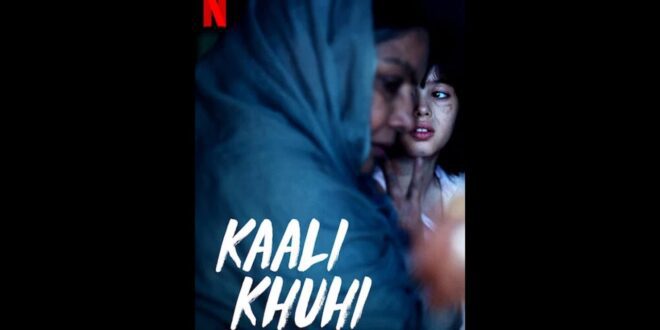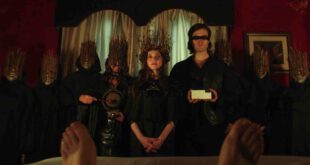I recently had the opportunity to chat with Terrie Samundra, the director of the new Netflix film, KAALI KHUHI (read our review – HERE). This was a great film and she’s an incredible filmmaker. Learn about her career, the inspiration behind this film, the casting process, and more.
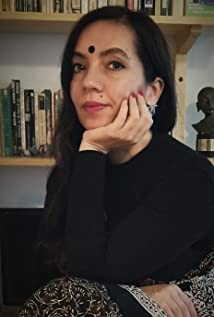
PopHorror – Hi Terrie, it’s wonderful to talk with you. What inspired you to work in this business?.
Terrie Samundra – I was always a weird art kid and did a lot of theatre, creative writing and was also an avid reader. And I loved storytelling and stories. My mother’s a Punjabi writer and poet and I grew up with her telling me tales, either ones that masked some real event or folklore she wanted to pass down to me. Some of my earliest film memories are from going to the cinema in India with her and my family. The films were 3 hours long with legitimate intermissions. I knew all the classic starlets and all the lyrics to all the songs. My mom also listened to Hindi film classics on repeat while she cooked and my favorite thing to be with her while she sang and cooked. It was my safe and happy place. Cinema has always been woven into Indian culture, and in my house it was part of the fabric. My father pretty much always had a camera with him. He taught me how to process film at home, in our makeshift darkroom. He also introduced me to film classics like The Searchers, Grapes of Wrath, the Blues Brothers and we watched a lot of 3 Stooges together. My parents were political activists and progressives, and that was also our community, so I think the seeds of storytelling, visual storytelling and curiosity of the human story started pretty early. But I took a long windy road to get to where I was actively making films.
PopHorror – That’s wonderful. You’ve done a lot of shorts and now you’re doing a feature called KAALI KHUHI that’s a Netflix original. How does it feel to have a film on Netflix?
Terrie Samundra – I’m really grateful that Netflix said yes to my first feature. Srishti Behl at Netflix India was my lead executive and creative head and she believed in the story. My producer Anku Pande brought the script to her and she loved the script from the beginning. Once we got greenlit, Netflix provided all of the support our team needed and gave us a lot of creative freedom to cast who we wanted, hire the best HOD’s, and give us space to work.
Right now film festivals are online and theatres are for the most part closed. If we didn’t have Netflix, I don’t know how people would see the film. We would have to shelve it and it would have fallen between the cracks. It’s an Indian Hindi language film, but people everywhere can access it, in the same way I watch a ton of International films and series from all over the world. For me, as an international filmmaker and director, it’s exciting and expansive.
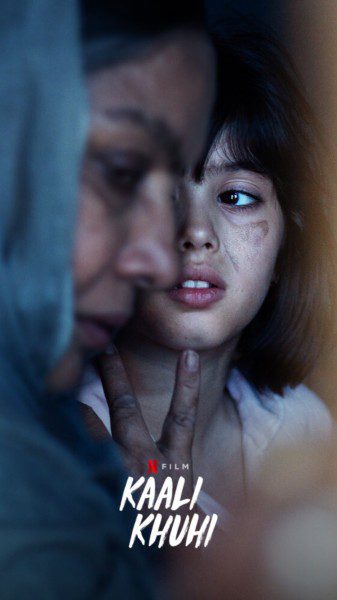
PopHorror – Most definitely! Can you tell the readers what this film is about?
Terrie Samundra – The film is about Shivangi, a ten year old girl who goes back to her family’s village when her grandmother falls ill. There she finds herself at the crux of a gruesome past of female infanticide and unforeseen future as the entire village is cursed and haunted. Events unfold revealing dark secrets and as the adults quickly grow incapable of helping, the fate of the village rests solely in Shivangi’s hands. Ultimately the film is about our protagonist claiming her right to exist, take up space and have self will and agency.
PopHorror – What inspired this film?
Terrie Samundra – From a young age I was surrounded by women who shared old tales and ghost stories in my family’s village in Punjab, India. I had a mental map of which houses were haunted. One story that always stayed with me is one my mother told me from when she was a little girl. It’s about a young woman and her baby girl who lived in the bottom of a well at the edge of an old field. The villagers said they saw her and her baby but knew they were ghosts because the young woman and child had died many years before. The mother and her child stayed to themselves and harmed no one, but if villagers used the well, soon after they would fall ill and die. Growing up, I also heard stories of methods used to terminate girl babies, using toxic plants. I learned the history of gender discrimination and violence woven into my own family’s story. That legacy of trauma and pain carried down through generations. The seed for ‘Kaali Khuhi‘ began when I started to imagine what it would be like to actualize the liberation of a painful past, and set free the trapped ghosts of a cultural poison using the visual art form of cinema.
PopHorror – I love that you used your personal experience and history for this story. As one of your first feature films, how did the casting process come about?
Terrie Samundra – We worked with an amazing Mumbai based casting director named Aadore Mukherjee. She put a list of potential people to go out to, and our producers added to the list. Sanjeeda Shaikh sent us an audition tape and she blew us away, as did Satyadeep Misra. For the kids, we had worked with Riva Arora six months prior when we shot a test scene of the film in pre-production. She is such a young, bright star, and we knew that we wanted her to play Shivangi. We auditioned many young girls for the roles of Chandni and Sakshi. Chandni was the hardest role to cast, because late in the film she becomes possessed and has to do some crazy things. That’s a lot to ask of a child actor. We would ask the children auditioning to act like a wild animal. Rose Rathod killed her audition, she was uninhibited and just went for it. Hetvi Bhanushali auditioned for Chandni, and then re-auditioned for Sakshi, the ghost. She’s a dancer and her physicality was critical to her performance of Sakshi, the Ghost. She’s also incredibly bright and intuitive and understood the layers of the story, and incorporated that into her character work.
Shabana Azmi was sent the script and I was over the moon when I found out that it resonated with her and she said yes. I’d always dreamed of working with her, ever since I saw the film Fire in my 20s and grew up with my parents loving her work and the films she was in. She’s the grande dame of Indian Cinema, especially parallel cinema, which is what the art scene has been called there. She brought so much gravitas to the character of Satya Masi and built that character in a way I only dreamed of.
I also had the chance to work with Punjabi regional actors who are some of my favorites, Jatinder Kaur and Samel John were a dream for me. Samuel does a lot of revolutionary street theatre and he’s one of my heroes. It meant a lot to me to have them say yes to the project.
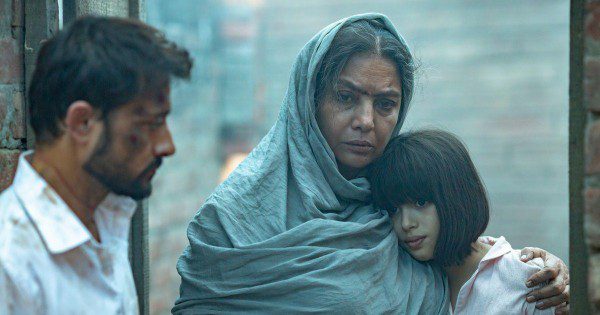
PopHorror – Sounds like a wonderful experience. Are there any scenes you are especially proud of or that were harder to film than others?
Terrie Samundra – Without giving away spoilers, the biggest audience response is to the final scene. It’s always been one of my favorite scenes, and the denouement of the film. In the script it seemed strange and illogical, which was intentional in that it’s a surreal scene, but not one person has questioned it after watching it. It’s transformative and emotional and exactly how we intended it.
That scene in particular was tough. Riva, who was only 8 at the time we were shooting, had to lead a very large and heavy buffalo through the village and fields and towards the well. We were not working with a trained film animal and Riva was a bit nervous but she did it, and was amazing.
There’s also another scene which is close to the build up of the climax. It’s when Baby is dragged in the rain and mud, by Shivangi. Baby’s possessed and maniacal, eventually bites down on Shivangi’s arm. Me and my AD’s had to really build up the girls for that scene. It was wild and fun and they killed it.
PopHorror – I loved both of those scenes – powerful! Is making a feature film much different than making a short?
Terrie Samundra – In most ways, I think it is. I think of comparing the two as if you’re trying to compare not only writing a short story to a novel but the actual literary form. A short film is not a smaller feature. It’s a different form of cinematic storytelling, and needs to be respected on it’s own terms. I love short films and a great short is genius. My favorite part about working in programming at film festivals was the discovery of a great short film. It felt like you were discovering a new voice.
With a feature, as far as the overall process, you’re not just making a film, you’re building a world within a world. And your film will evolve a million times, from script to final lock of the edit. Although there are standard procedures everyone follows, each feature production is different and has to serve it’s story, crew and the way the team intends to work. I know people working on five person feature crews and then there’s crew in the hundreds.
PopHorror – When people watch this film, what would you like them to take away from it?
Terrie Samundra – First and foremost is the story. I never intended to lecture or give a bunch of information to the audience, but to create an immersive experience using cinematic language, which includes amazing sound design, score, art design, wardrobe and everything our entire cast and crew built. But the underlying story of KAALI KHUHI is that it’s a grounded horror film rooted in the real horrors of female infanticide and the poison of patriarchy. I hope I’ve created space in the film for the viewer to bring themselves into it and to make it a part of their inner world. If it sparks something inside and perhaps even a conversation, I’ve done what I set out to do.
Similarly, the film was always meant to be small in scope. As the script attracted big name stars like Shabana Azmi, it got bigger in budget and scope, and it seems that the importance of addressing every nuance of female infanticide has come down on this film. I have read some great criticisms about the film which have stated that I put the burden of this social evil completely on the women of the story, and let the men off. I think it’s a valid argument, and perhaps I never addressed this because this is a very personal story to my family and I wanted to keep it about the intergenerational relationships between the women. Currently it’s the #3 most watched film on Netflix in India, so it hit a nerve and the fact that people are watching a film helmed by girls and women, rooted in the issue of patriarchy, I feel I have done a good thing.
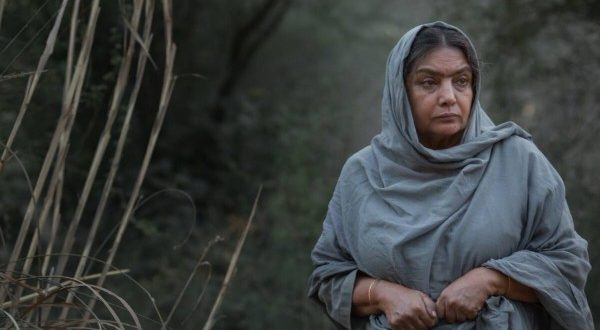
PopHorror – It’s a beautiful thing. You should be proud of what you accomplished! Any other projects you’d like to talk about?
Terrie Samundra – I have a few projects brewing. I primarily write with my husband and creative partner, David Walter Lech. We have a couple of pilots and two features that are out, and we’re also developing a new feature. Since things are incredibly unpredictable in an already unpredictable industry, at least we can always write. Writing has always been a place of artistic liberation and self agency so for now we develop stories and write.
 PopHorror Let's Get Scared
PopHorror Let's Get Scared
